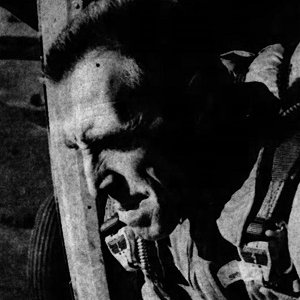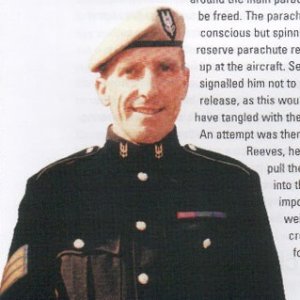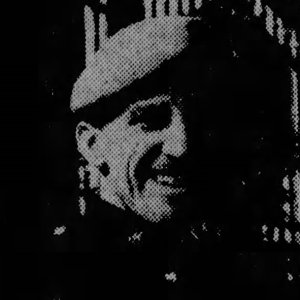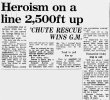- SURNAME
Reeves
- FORENAME
Michael Reginald (Mick)
- UNIT
D Squadron (16 Troop)
- RANK
Sergeant
- NUMBER
21012013
- AWARD
George Medal
- PLACE
England 1967
- ADDITIONAL INFORMATION
emigrated to Rhodesia 1970s
Rhodesian SAS (Territorial)
died 2016, South Africa
London Gazette 44528, 16th February 1968, Page 2072
CITATION:
George Medal : On 17th September 1967, Sergeant Reeves, who is a fully qualified free fell parachute instructor, was voluntarily teaching pupils from the Herefordshire Free Fall Club. Parachuting was taking place in the South Staffordshire area of Halfpenny Green.
During the afternoon Sergeant Reeves briefed the pilot of the Rapide Aircraft and the students, and having made all checks, the aircraft was requested to take off for its first pass at an altitude of 2,500 feet. There were two students on learner line drops and a number of others on normal free fall descents prepared for up to 20 second delays.
The first student went away well and his static line was pulled in. The second student jumped on the instructions of Sergeant Reeves. His static line failed to open his parachute and he was left dangling some 16 feet below in the slipstream of the aircraft. Sergeant Reeves at once saw that the static line had fouled round the main parachute and could not be freed. The parachutist was conscious but spinning. The man was holding his reserve parachute release and looking up at the aircraft. Sergeant Reeves signalled him not to pull his reserve as this would, on development have removed the tail off the Rapide. Also by now the aircraft was well away from the Drop Zone and over rough country and buildings. An attempt was then made by Sergeant Reeves, helped by others, to pull the parachutist back into the aircraft. This was impossible owing to the weight and drag created by the forward speed of the Rapide.
Sergeant Reeves then decided that the only way to save the learner parachutist, who had never previously pulled his own parachute was to climb down the static line and carry out the rescue task himself. Before leaving the aircraft he instructed the pilot to gain us much height as possible and return to the drop zone. Sergeant Reeves gave his rigger's knife to an accomplice in the aircraft with orders to cut the static line when he signalled. He then climbed dorm the static line holding on against the force of the slipstream. The friction caused burnt through his gloves causing some blistering to his hands.
When Sergeant Reeves arrived at the end of the static line he found the learner parachutist had kept his head and was calm, though he was suffering from a severe buffeting and rough ride. He further reassured him. It was quickly apparent that the static line could not be freed from the parachute. Sergeant Reeves held the parachutist and then gave the signal to cut the static line to those in the aircraft. This was done and Sergeant Reeves went into free fall holding the learner parachutist. When clear of the aircraft Sergeant Reeves pulled the learner parachutist's reserve parachute. Still holding together, he watched its successful deployment to ensure the 16 foot of static line did not entangle the canopy and that the learner was in control once deployment was effected.
Sargant Reeves separated from the learner parachutist and, when he had put sufficient free fall flight between them for safety, he pulled his own main parachute. By then he was at a height a little lower than is considered usual for normal parachute deployment. Both he and the learner parachutist landed without mishap.
Throughout the whole incident Sergeant Reeves displayed courage and a cool nerve, showing leadership and decisive action which prevented a fatal accident taking place to the learner parachutist and ensuring the safety of the aircraft and those in it.
Place : South Staffordshire (Halfpenny Green area)
Date of Action : 17th September, 1967
How Employed : Voluntary capacity as Jumpmaster with civilian Herefordshire Free Fall Club
During the afternoon Sergeant Reeves briefed the pilot of the Rapide Aircraft and the students, and having made all checks, the aircraft was requested to take off for its first pass at an altitude of 2,500 feet. There were two students on learner line drops and a number of others on normal free fall descents prepared for up to 20 second delays.
The first student went away well and his static line was pulled in. The second student jumped on the instructions of Sergeant Reeves. His static line failed to open his parachute and he was left dangling some 16 feet below in the slipstream of the aircraft. Sergeant Reeves at once saw that the static line had fouled round the main parachute and could not be freed. The parachutist was conscious but spinning. The man was holding his reserve parachute release and looking up at the aircraft. Sergeant Reeves signalled him not to pull his reserve as this would, on development have removed the tail off the Rapide. Also by now the aircraft was well away from the Drop Zone and over rough country and buildings. An attempt was then made by Sergeant Reeves, helped by others, to pull the parachutist back into the aircraft. This was impossible owing to the weight and drag created by the forward speed of the Rapide.
Sergeant Reeves then decided that the only way to save the learner parachutist, who had never previously pulled his own parachute was to climb down the static line and carry out the rescue task himself. Before leaving the aircraft he instructed the pilot to gain us much height as possible and return to the drop zone. Sergeant Reeves gave his rigger's knife to an accomplice in the aircraft with orders to cut the static line when he signalled. He then climbed dorm the static line holding on against the force of the slipstream. The friction caused burnt through his gloves causing some blistering to his hands.
When Sergeant Reeves arrived at the end of the static line he found the learner parachutist had kept his head and was calm, though he was suffering from a severe buffeting and rough ride. He further reassured him. It was quickly apparent that the static line could not be freed from the parachute. Sergeant Reeves held the parachutist and then gave the signal to cut the static line to those in the aircraft. This was done and Sergeant Reeves went into free fall holding the learner parachutist. When clear of the aircraft Sergeant Reeves pulled the learner parachutist's reserve parachute. Still holding together, he watched its successful deployment to ensure the 16 foot of static line did not entangle the canopy and that the learner was in control once deployment was effected.
Sargant Reeves separated from the learner parachutist and, when he had put sufficient free fall flight between them for safety, he pulled his own main parachute. By then he was at a height a little lower than is considered usual for normal parachute deployment. Both he and the learner parachutist landed without mishap.
Throughout the whole incident Sergeant Reeves displayed courage and a cool nerve, showing leadership and decisive action which prevented a fatal accident taking place to the learner parachutist and ensuring the safety of the aircraft and those in it.
Place : South Staffordshire (Halfpenny Green area)
Date of Action : 17th September, 1967
How Employed : Voluntary capacity as Jumpmaster with civilian Herefordshire Free Fall Club
WEB LINKS:
• https://www.thegazette.co.uk/London/issue/44528/supplement/2072NATIONAL ARCHIVES:
https://discovery.nationalarchives.gov.uk/details/r/D7637034
Last edited by a moderator:







